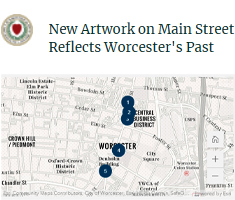The City of Worcester encourages and promotes the enrichment of the city's cultural landscape through aesthetic improvements to public spaces, uniting artists and community while inspiring civic pride. The City of Worcester's Public Art Working Group (PAWG) is made up of local citizens and art lovers who are committed to supporting local public art initiatives.
PAWG goals are to:
- Commission large-scale public art projects
- Support local and regional artists in the development of public art throughout the city
- Encourage and foster the engagement of young people and the general public in creating public art
To learn more and get involved with PAWG, please contact Culture@worcesterma.gov.
WooBoxes
The WooBox Art Project is a municipally led initiative designed to transform ordinary utility boxes into vibrant public artworks that celebrate Worcester's creativity and community spirit. From bustling intersections to quiet corners, each WooBox installation adds a burst of creativity to our shared public spaces.
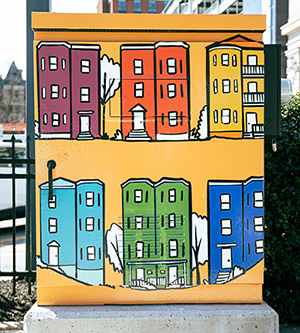
Main Street Reimagined
The Main Street Reimagined initiative complimented the $11 million reconstruction of Worcester's Main Street, from Lincoln Square (Highland and Belmont Streets) to the north to Chandler and Madison Streets to the south. Through public art and intentional connectivity, as well as widened sidewalks, dedicated bike lanes, refreshed light fixtures and new crosswalks, a sense of place has been created along Main Street by improving walkability, public safety and vibrancy. The custom public art installations - including functional and decorative elements - activate these previously underutilized public spaces. The installations reflect elements of Worcester's history, culture and community in creative and interesting ways.
Through its Public Art Working Group (PAWG), the City of Worcester has procured or commissioned artwork for its Main Street Reimagined initiative in partnership with the Worcester Cultural Coalition and the Urban Culture Institute. Phase one was installed in November 2021, with installation of phase two and permanent signage planned for spring 2022.
Main Street Reimagined Art Pieces
The five features below are just a few of many pieces procured or commissioned by the City of Worcester in support of its Cultural Plan and the Main Street Reimagined initiative.
Gianna Stewart
Powder-coated steel and enamel
According to local folklore, Worcester resident Esther Howland received a valentine from an admirer in 1847, and from that small card a big idea grew. She started selling her own cards through her father's stationary store. Business flourished, and Howland recruited friends to help assemble intricate, multi-layered cards in an all-female assembly line. Born in Worcester, this successful woman-owned-and-operated business helped popularize the valentine as we know it today.
In 1879, Howland partnered with another local valentine maker - Edward Taft - and card assembly continued as the New England Valentine Company, located at Harrington Corner. The company was later incorporated into the George C. Whitney Company, which helped Worcester become a center of the American valentine card industry. The Whitney Company was one of America's leading producers of valentines until World War II, when wartime paper shortages caused the liquidation of the world's largest greeting card company.
Howland's business success and the wide distribution of her valentines made her a well-known figure in American valentine history. Artist Gianna Stewart found inspiration for this bench in the layers of intricate lace paper and pop up elements found in Howland's valentines. Depending on one's viewpoint, the cutouts frame passersby, the streetscape or the person sitting in the bench, "as if a pop-up part of the valentine," Stewart said.
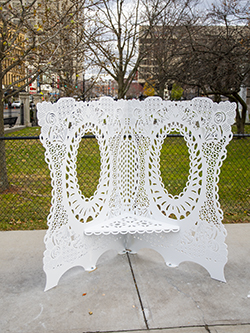
Jennifer Rubin Garey
Steel
In a time when bodies were expected to conform to fashion, and not the other way around, the corset was an essential garment. By cinching the wearer's waist and boosting the bust, a tightly-laced corset was also believed to offer a woman support in an era when many viewed a woman's body as inherently weak. Founded in 1872, the Royal Worcester Corset Company was one of 6 corset companies in Worcester by 1910. At its height, Royal Worcester employed nearly 2,000 people, and at one point was one of the largest employers of women in the country. Over time, the corsets' popularity declined in favor of two-piece undergarments, which offered greater mobility, and Royal Worcester closed in 1950.
"Flat Curves" sculptor Jennifer Rubin Garey's work focuses on challenging physical standards, noting them as, "self-imposed in response to societal expectations and our own innate need to conform." Garey finds that conscious and unconscious pressures deny individuality and humanity - especially clothing which forces the natural body into unnatural shapes: "Our true form may or may not be consistent with the contemporary idealized image of a beautiful, successful woman."
The corset remains well-known in Worcester's fashion and production history, and Worcester was also home to many clothing makers and sellers throughout the years. From where "Flat Curves" stands now, for decades one could see three major department stores - Macy's, Marcus's and Denholm's. The buildings have been repurposed as each closed, but fashions of years gone by remain popular in the many vintage shops still within the City.
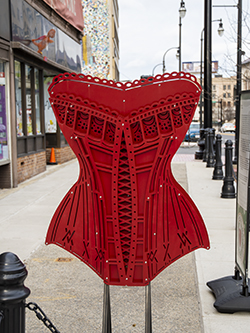
José Criollo Guncay
Recycled materials
Without saying a word or playing a note, the mere image of a guitar can strike a chord with music lovers. First shown as part of a public art exhibition in Elm Park, the City of Worcester purchased José Criollo Guncay's "GUITAR" to commemorate its musical heritage, and to continue celebrating it for years to come. "GUITAR" now lives across the street from one of Worcester's most iconic active venues - The Palladium.
Criollo, an Ecuadorian artist who now lives in Worcester, created "GUITAR" from recycled cars, tools and furniture. In their original purposes, these materials serve for work, transportation and relaxation. The combination of these pieces into a guitar was for more than the "cool" factor - the materials come together to become an instrument used to tell our stories through music, and to also share an important message about our environment:
"Con esta obra quiero dar un mensaje ecológico: mostrar que la basura en manos de un artista, ya no contamina, se transforma. Espero que usted, cómo espectador, pueda ver a la basura de otra forma." - José Criollo Guncay
"With this piece of artwork, I want to deliver an ecological message: to show that trash in the hands of an artist does not contaminate, but rather transforms into art. I hope that you, as a spectator, look at trash differently." - José Criollo Guncay

A+J Art+Design / Ann Hirsch and Jeremy Angier
Stainless steel, LED light fixture, granite base
At a time when women were expected to be quiet, Worcester abolitionist and suffragist Abby Kelley Foster was an outspoken social reformer. For decades she travelled the U.S. first advocating for the abolition of slavery and later for women's rights, despite threats to her safety from polite society and angry mobs alike. As Lucy Stone wrote, Kelley Foster, "earned for us all the right of free speech."
"A lectern compels interaction, evokes public speech, and inspires engagement," noted artist team A+J Art+Design. They anticipate the public will question the seemingly-unusual placement of a lectern on Main Street, and hope viewers might, "stand at it to imagine what it would mean to deliver a speech to strangers passing by; a small window into the enormity of Foster's acts of revolution, bravery, and humanity." The design includes cutouts of words from Kelley Foster's handwritten letters and her 1851 speech at the Second National Women's Rights Convention in Worcester, a medal which the British and Foreign Anti-Slavery Society awarded to Massachusetts Abolitionists (chief among them Kelley Foster), and a pen with blank pages to "reinforce the theme of using one's voice to stand up for social change."
"Bloody feet, sisters, have worn smooth the path by which you have come hither." - Abby Kelly Foster in her speech at the Women's Rights Convention, Worcester, MA, 1851
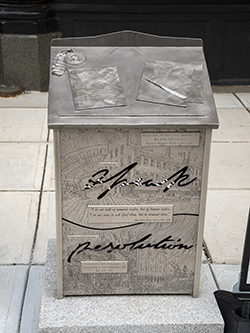
Artist: Bartek Konieczny, Designer: Ray Dunetz Landscape Architecture
Galvanized steel, IPE wood slats
In 1840, Worcester manufacturing brothers Loring and Aury Gates Coes invented a screw-based wrench, which later became commonly known as the "monkey wrench." Unlike earlier wrenches, the Coes brothers' version could be adjusted with one hand and adapt to a variety of nut and bolt sizes, which were not yet standardized. Such an invention was important in a factory city like Worcester, a significant improvement to efficiency in machine adjustments and repairs. The Coes' wrenches adapted to changing times and evolving applications - from factory machines to bicycles and automobiles. For the monkey wrench and more, the Coes brothers were industrial leaders in a city of innovation and enterprise.
In 1842, workers in Worcester formed the Mechanics Association to help members develop skills and gain education needed to run machinery in local mills. Having outgrown rented spaces, in 1857 the Worcester County Mechanics Association built Mechanics Hall to house both educational and cultural activities, as it still does today. When it opened, Mechanics Hall represented state-of-the-art mechanical systems and construction techniques: a testament to the skill and ingenuity of local artisans and tradesmen.
Combining culture, history and art, "Wrench Bench" designers paid tribute to both the development of the monkey wrench and the contributions of the Mechanics Association. The functional whimsy of the finished product also invites civic pride, with the message "Made in Worcester" printed on the handle.
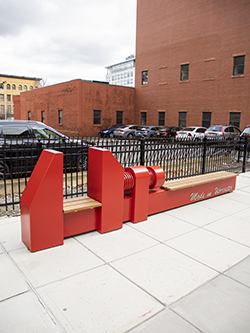
Additional Public Art Locations
View our Map & Database of existing public art throughout the City, highlighting murals, memorials, statues and other art installations.


